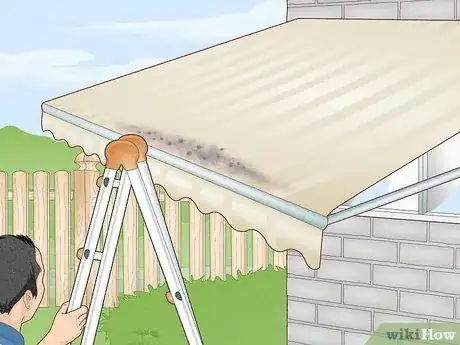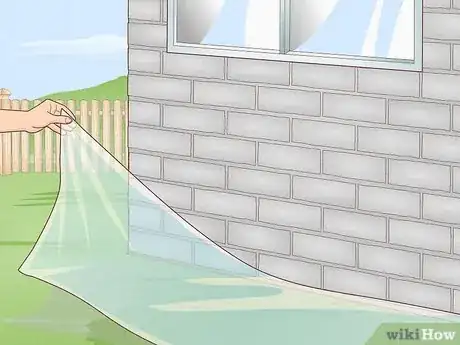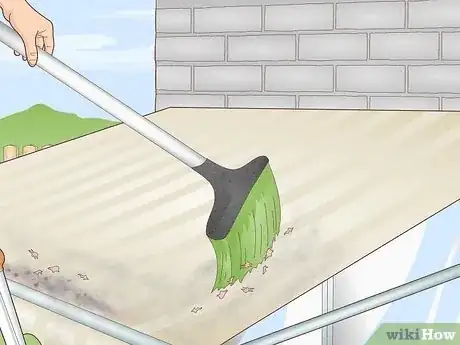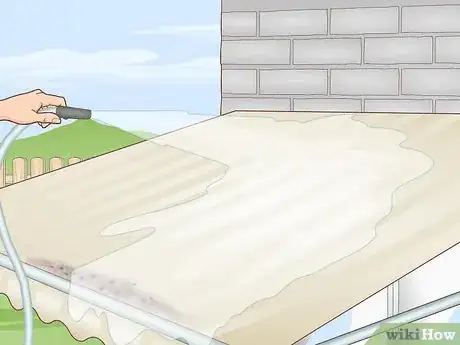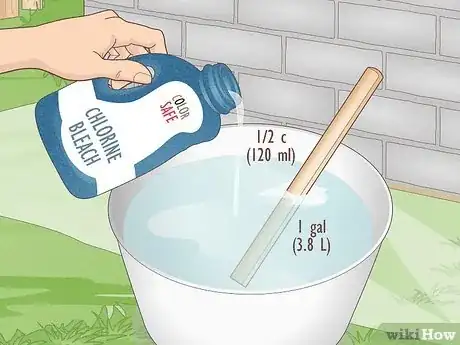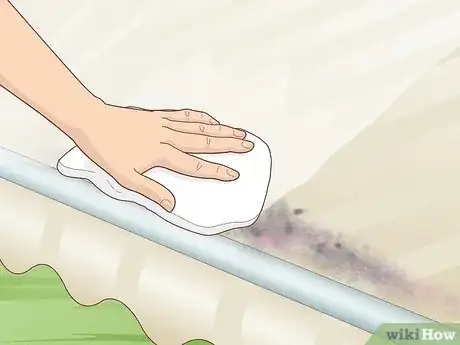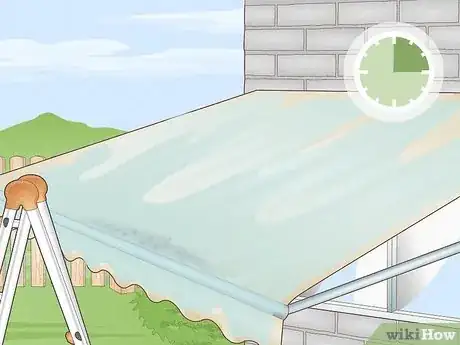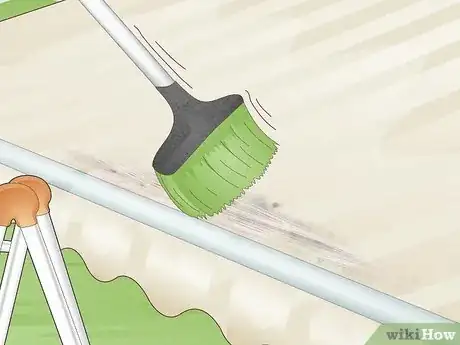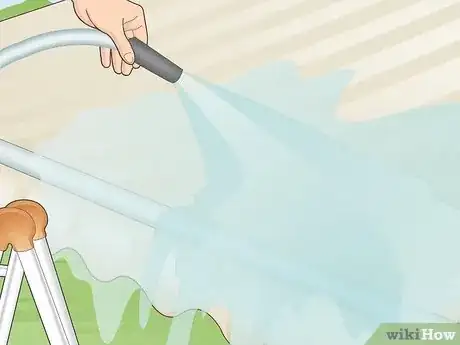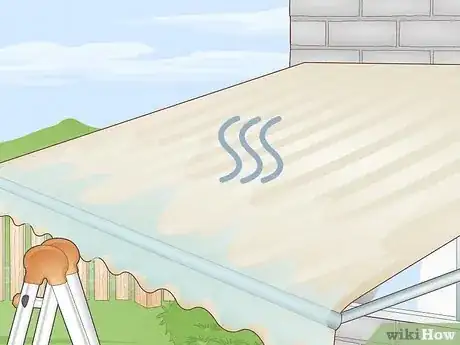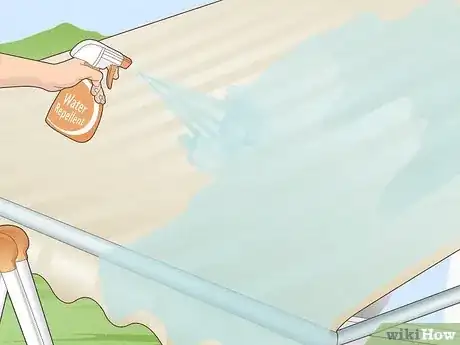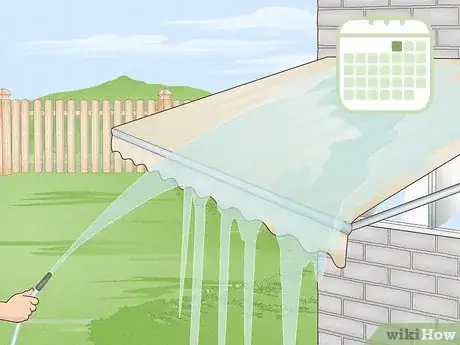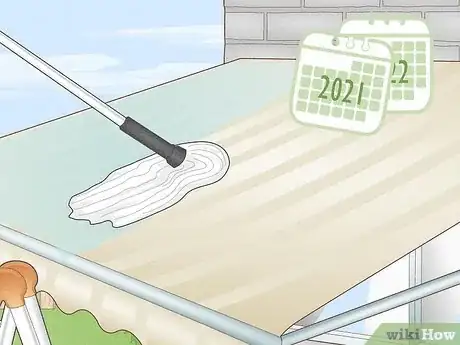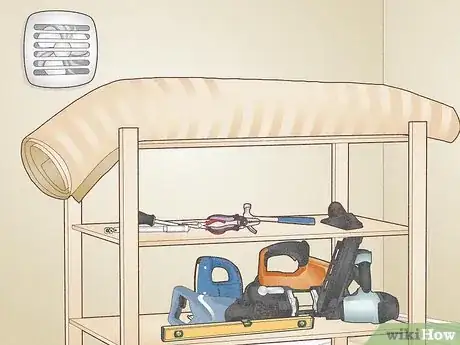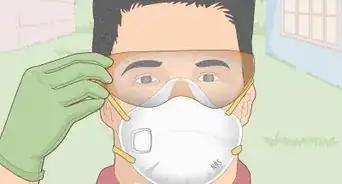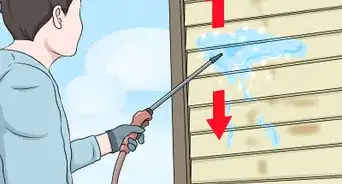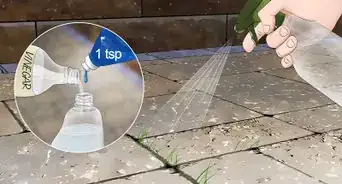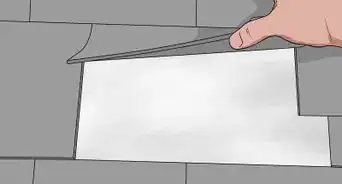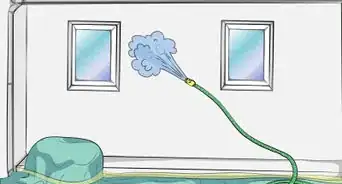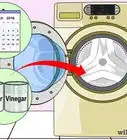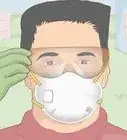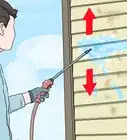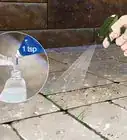This article was co-authored by Mike Kapur and by wikiHow staff writer, Hunter Rising. Mike Kapur is a home inspector and the owner of Sonic Home Inspections, a home inspection company in Westchester, New York. With over 15 years of experience in pre-inspecting properties, Mike specializes in mold, radon, asbestos, lead, water, and air quality testing as well as hazardous materials, pest, infrared, and general home inspections. Prior to founding Sonic Home Inspections, Mike worked pre-inspecting apartments. Mike holds a BS in Accounting from Queens College and is a Certified Mold Assessor in the state of New York.
There are 12 references cited in this article, which can be found at the bottom of the page.
This article has been viewed 159,575 times.
Canvas awnings on your home or RV are usually durable to the elements, but even they could develop some unsightly mold and mildew over time. We know that you want to make your awnings look like the day you first put them up, and the good news is that they're really easy to clean with some supplies you probably already have at home. Keep reading for the best way to get that pesky mildew off your awnings and how to stop it from coming back.
Steps
Removing Dirt and Debris
-
1Set up a ladder to clean off your awnings. Awnings are easiest to clean when you leave them open or up in their frame. Choose a ladder that has a step or platform on top where you can easily keep your cleaning supplies. Place a ladder next to your awning so you can climb up safely and reach the canvas.[1]
- If you’re cleaning an RV awning, you may only need a step ladder instead.
-
2Cover the ground and nearby items with plastic tarps. The cleaning solution to remove mold contains bleach, which could damage plants and any other objects directly under the awning. Put a plastic tarp on the ground underneath the awning to catch any spills or drips while you’re cleaning.[2]Advertisement
-
3Brush debris off the awning with a soft-bristled broom. Start at the top of your awning and brush down the surface with your broom. Apply gentle pressure to knock off any leaves, sticks, twigs, cobwebs, or dirt that accumulated on the awning. Once you clear the awning of debris, it’ll be a lot easier to fully clean.[3]
- Leaving debris on your awning can cause damage and make it more likely for mosses and mildew to form.
- Mildew looks like gray or black powder that sticks on your awning even after you brush it.[4]
- Green or brown splotches on your awning are either moss or lichens. You can still get rid of both the same way you’d remove mildew.
Cleaning Mold and Mildew off a Canvas Awning
-
1Hose down the awning. Spray your awning with a garden hose to get it completely wet. If you don’t have a hose, just climb your ladder and wipe your awning with a wet cleaning cloth or sponge.[5]
- The water will make it easier for you to spread the cleaning solution so the mildew comes off quicker.
-
2Mix a cleaning solution with bleach and water in a bucket. Add 1⁄2 c (120 ml) of chlorine bleach, , and 1 gallon (3.8 L) of water in a large bucket and stir until it’s thoroughly combined. The bleach will kill any mold spores on your awning.[6]
- Since bleach can irritate your skin, put on a pair of rubber gloves before you start cleaning.
- For a natural alternative, use white vinegar.[7]
- You can instead use a commercial mold and mildew remover if you don’t want to mix your own.
- Test your cleaning solution on an inconspicuous spot of your awning to make sure it doesn’t make the colors bleed. Let the solution sit for 20 minutes before rinsing and checking for discoloration.
- Never mix bleach or other cleaning solutions with soap, as it can create toxic gas.[8]
-
3Wipe the cleaning solution onto your awning with a cloth or sponge. Dip the clean cloth or sponge into your cleaning solution and spread it onto your awning. Rewet your cleaning cloth as it dries out until you soak the awning completely.[9]
- Your ladder could be slippery if you spill any of your cleaning solution on it, so keep both feet planted so you don’t lose your balance.
- If you aren’t able to reach parts of your awning, use a long-handled sponge mop instead.[10]
-
4Let the cleaning solution sit for 15 minutes. Your cleaning solution needs time to soak into the fabric so it can kill the mold and mildew. Leave your awning open the whole time while the solution soaks in.[11]
- Avoid letting the cleaner sit for 20 minutes or longer, since it may discolor your awning.
-
5Scrub the canvas with your broom. After the cleaning solution has had some time to soak in, take your soft-bristled brush and scrub the top side of the awning. Apply gentle pressure to break apart the moss, mildew, and mold on the surface.[12]
- If the cleaning solution starts to dry anywhere, re-soak the area before you scrub.
- Avoid using brushes with stiff bristles since they could damage the finish or fabric.
-
6Rinse the awning with water. Once you scrub the whole awning, spray it with clean water from your hose or wipe it down with a damp cloth. Continue rinsing your awning until the water runs clear to ensure there isn’t any cleaning residue left on the fabric.[13]
- Cleaner residue left on your awning could cause fabric discoloration when it’s left out in the sun.
-
7Let the awning air-dry completely. If you left your awning attached to its frame, just keep it open so it can dry out. After a couple of hours, the sun and breeze will dry your awning out so it’s safe to put away.[14]
- Rolling up or putting your awning away while it’s still wet makes it easier for mold or moss to grow back.
- If there's any mildew left on the awning, soak it in your cleaning solution and gently scrub it again. It may take a few cleanings to completely remove stubborn mildew or mold.
-
8Apply a reproofing spray onto your awning. Using a cleaning solution may have removed the water- and stain-proofing surface from your awning. Get a reproofing spray and apply an even coat directly onto the canvas once it’s dry. After you apply the first coat, let it dry for 5–10 minutes. Apply a total of 3 coats of the reproofing spray to keep your canvas awning protected.[15]
- If you forget to reproof your awning, mold and mildew will grow faster since there isn’t a waterproof barrier over the fabric.
Preventing Mold and Mildew
-
1Hose down the awning monthly. Stand on the ground or on a ladder, and use a low-pressure attachment on your hose to spray the canvas until it’s thoroughly soaked. After you rinse it, leave it open until it’s completely dry.[16]
- Hosing down the awning removes dirt, organic matter, and other things that could lead to mildew growth.
-
2Clean your awnings yearly. Carve out a day each year to clean your awnings so they never have a chance to get too dirty. Just soak the awning with water, scrub on a mixture of 1 gallon (3.8 L) of water and 1⁄4 cup (59 ml) of mild liquid soap, rinse it out completely, and let it dry. That way, you remove any pollutants, organic matter, dirt, and contaminants from the surface.[17]
- You only need to use bleach if you notice mildew or mold growing on your canvas.
-
3Store your awning in a dry place. Moisture is what causes mold and mildew to grow.[18] Whenever you need to roll up an RV awning, wait until it’s completely dry before storing it. If you’re taking your awnings down for the season, make sure you keep the awning in a well-ventilated area that’s safe from moisture, or else mildew or mold can grow on the fabric.[19]
Expert Q&A
-
QuestionIs there an easier cleaning solution that doesn't involve bleach?
 Dario RagnoloDario Ragnolo is the Owner and Founder of Tidy Town Cleaning, a home cleaning service in Los Angeles, California. His business specializes in residential & commercial cleaning. He is a second generation home cleaning expert, who grew up around his parents cleaning business in Italy.
Dario RagnoloDario Ragnolo is the Owner and Founder of Tidy Town Cleaning, a home cleaning service in Los Angeles, California. His business specializes in residential & commercial cleaning. He is a second generation home cleaning expert, who grew up around his parents cleaning business in Italy.
House Cleaning Professional Yes, you could always just use laundry detergent and hot water. Apply it with a brush and then rinse the canvas off.
Yes, you could always just use laundry detergent and hot water. Apply it with a brush and then rinse the canvas off. -
QuestionWill a weak chlorine solution, used to clean a canvas awning, discolor the painted deck under the awning?
 wikiHow Staff EditorThis answer was written by one of our trained team of researchers who validated it for accuracy and comprehensiveness.
wikiHow Staff EditorThis answer was written by one of our trained team of researchers who validated it for accuracy and comprehensiveness.
Staff Answer wikiHow Staff EditorStaff AnswerThe solution may discolor your deck, so put down a layer of plastic tarps to catch any drips.
wikiHow Staff EditorStaff AnswerThe solution may discolor your deck, so put down a layer of plastic tarps to catch any drips. -
QuestionWill this solution discolor a dark green canvas?
 Community AnswerNo, it will not, as long as the canvas is designated "outdoor" or "indoor/outdoor." You can clean most outdoor furniture and cushions without any problems. I own a pressure washing company and I've washed several outdoor surfaces and the main chemical I use is pool chlorine (bleach). I never mix it stronger than 5 parts water/detergent to 1 part chlorine.
Community AnswerNo, it will not, as long as the canvas is designated "outdoor" or "indoor/outdoor." You can clean most outdoor furniture and cushions without any problems. I own a pressure washing company and I've washed several outdoor surfaces and the main chemical I use is pool chlorine (bleach). I never mix it stronger than 5 parts water/detergent to 1 part chlorine.
Warnings
- Avoid mixing bleach with any other cleaners, including vinegar or soap, since it can create harmful gasses.[20]⧼thumbs_response⧽
Things You’ll Need
References
- ↑ https://youtu.be/CEPRj3hA4T4?t=211
- ↑ https://hd-v8-data-prod.s3.amazonaws.com/current/docs/timeless-collection-awnings-care-cleaning.pdf
- ↑ https://brellafabrics.com.au/wp-content/uploads/2015/05/Brella-Awning-Canvas-Care-2011.pdf
- ↑ https://www.cleanipedia.com/gb/in-the-home/what-is-mildew-and-how-to-deal-with-it.html
- ↑ https://www.alamedacanvas.com/Sunbrella%20Cleaning.pdf
- ↑ Mike Kapur. Certified Mold Assessor & Home Inspector, Sonic Home Inspections. Expert Interview. 19 August 2020.
- ↑ Mike Kapur. Certified Mold Assessor & Home Inspector, Sonic Home Inspections. Expert Interview. 19 August 2020.
- ↑ https://www.cdpr.ca.gov/docs/dept/factshts/bleach_soap.pdf
- ↑ https://www.cleanipedia.com/au/floor-and-surface-cleaning/clean-canvas-awning.html
- ↑ https://www.awningswholesaler.com.au/Care%20of%20Canvas%20&%20Acrylic.pdf
- ↑ https://www.awningswholesaler.com.au/Care%20of%20Canvas%20&%20Acrylic.pdf
- ↑ https://brellafabrics.com.au/wp-content/uploads/2015/05/Brella-Awning-Canvas-Care-2011.pdf
- ↑ https://recasensusa.com/wp-content/uploads/2017/03/maintenance_warranty_recasens_en.pdf
- ↑ https://www.cleanipedia.com/au/floor-and-surface-cleaning/clean-canvas-awning.html
- ↑ https://youtu.be/FO9JZjYz9Vo?t=29
- ↑ https://recasensusa.com/wp-content/uploads/2017/03/maintenance_warranty_recasens_en.pdf
- ↑ https://recasensusa.com/wp-content/uploads/2017/03/maintenance_warranty_recasens_en.pdf
- ↑ Mike Kapur. Certified Mold Assessor & Home Inspector, Sonic Home Inspections. Expert Interview. 19 August 2020.
- ↑ https://hd-v8-data-prod.s3.amazonaws.com/current/docs/timeless-collection-awnings-care-cleaning.pdf
- ↑ https://doh.wa.gov/you-and-your-family/healthy-home/home-contaminants/dangers-mixing-bleach-cleaners
About This Article
To remove mildew from a canvas awning, you can use your own cleaning solution made with bleach. First, brush off any dirt and debris from the awning with a broom. If possible, take your awning off of its frame and clean it on a flat surface to make the process easier. Once you’ve brushed everything off, hose the awning down until it’s completely wet to make it easier for the cleaning solution to spread. Then, prepare your cleaning solution by mixing 1 cup bleach, 1/4 cup mild liquid soap, and a gallon of cool water in a bucket. Dip the awning into the mixture, covering every inch of the fabric, and give it 15 minutes to soak. After the cleaning solution has had time to soak, scrub the top of the fabric with a soft-bristled brush before rinsing it off with the hose. To dry your awning, either hang it on a clothesline or let it sit on its frame. For more help, like how to re-treat your awning, read on.
